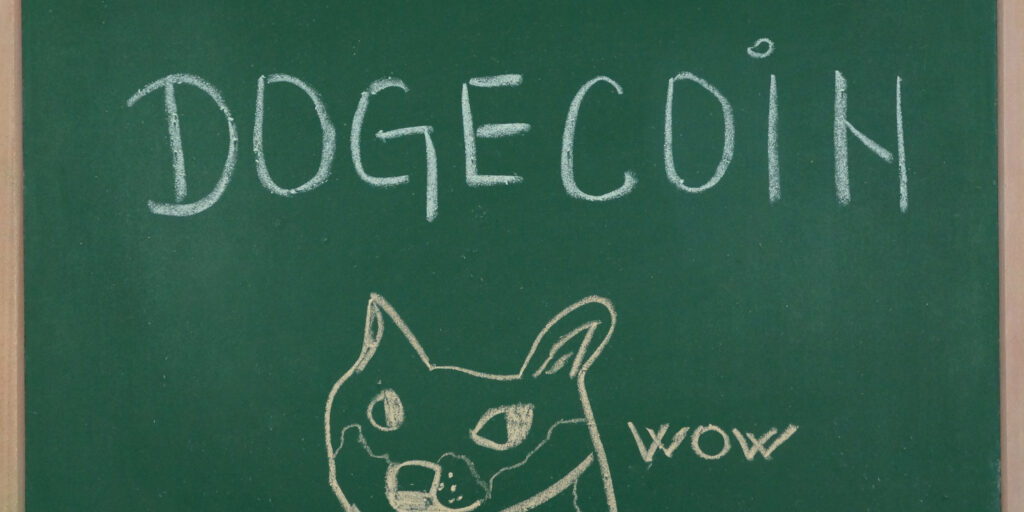Is Dogecoin the ultimate illustration of the crassness of crypto, or is there a more meaningful side to the Shibu Inu themed meme-coin?

In 2013, Billy Markus spent three hours creating Dogecoin, a cryptocurrency only intended to be a joke. Today, it has a market capitalisation of over $8.5 billion and is being hyped by one of the world’s richest men. So, is Dogecoin a joke, a Ponzi or something more important?
Dogecoin, the nerdy joke
There are six references at the end of Bitcoin’s whitepaper, a testament to the work, spanning the preceding decades, that inspired its creator, Satoshi Nakamoto.
In contrast, Billy Markus and Adobe Product Manager Jackson Palmer wanted Dogecoin to be as ridiculous as possible. Of the three hours that it took the pair to bastardise Bitcoin’s code and create Dogecoin, the majority was spent on a comedy font:
It took about 3 hours to make, with the bulk of that time making alterations to the client to make the text Comic Sans and some custom graphics and wording for different pieces of the UI.
An open letter from Billy Markus on Reddit
But before dismissing Dogecoin as a nerdy joke, realise that being open source is a feature of crypto, not a bug.
Money is no longer the sole preserve of central bankers. Satoshi Nakamoto created a blueprint for anyone to copy.
It just so happens that Markus and Palmer decided to make a copycat cryptocurrency featuring a cute Japanese hunting dog as a figurehead and a deliberately naff interface. No one was forced to buy and use it, but plenty did and still are.
So what’s the point of Dogecoin?
Dogecoin has no whitepaper, but Markus described on Reddit what he thinks makes Dogecoin worthwhile is
“Joy, kindness, learning, giving, empathy, fun, community, inspiration, creativity, generosity, silliness, absurdity.”
Everything about Dogecoin in the early days was a lampoon. The total supply – 100 billion – was set so high to discourage anyone from taking it seriously as a store of value.
Even the block reward – for those mining it – was randomised, meaning you might get nothing for your proof-of-work efforts or hit the jackpot. Again intended to discourage anyone doing it for anything other than shits and giggles.
That might seem naively idealistic, but money with a conscience and sense of humour served as a perfect antidote to the arrogance, ignorance, and self-serving greed of Wall Street.
The generation scarred by the failed alchemy of the 2008 Financial Crisis was a natural audience for a more joyous and empathetic form of money.
How a meme has inspired a movement
When the 2008 crisis hit, and people felt the impact, there was widespread dismay. Bankers became enemy no.1 – and arguably still are – but it was hard for average Joe to understand what had actually gone wrong.
It is important to try and explain what money is, but from a formal perspective, it is a largely impenetrable subject. So, rather than being just a cute pooch, maybe Dogecoin was more like a Trojan Horse?
Hiding inside that cute Japanese hunting dog was an important message – everyone has the power to create value, and you can choose to do something good and fun with it, maybe even ridiculous.
As users engage with the memes and the humour, some will scratch beneath the superficial surface and learn some important lessons about what money represents and how crypto is the newest battleground in control of it.
Dogecoin was the perfect guerilla marketing campaign to get millennials thinking about a problem they may have been unable to articulate but would certainly have felt – financial impotence.
Dogecoin – dumbing down technobabble & tokenomics
In marketing, the process of trying to get people’s attention in relation to a specific problem is called the awareness funnel. At the bottom are people who understand the problem and look at ways to solve it. At the top are those who don’t even know they have a problem.
To maximise audience, marketers try and build as wide as funnel as possible at the top, which means trying to attract people who don’t even know they have a problem yet.
Simplified messaging can then act like a breadcrumb trail leading towards more sophisticated and intent-based ideas, like the Cantillon Effect or rent-seeking; subjects that can explain the frustrations of the average person but lack the appeal of a cute dog.
It may not be explicitly intended, but I think this is what Dogecoin is doing. Most cryptocurrencies – of which there are literally thousands – present themselves as offering a profound new technical solution to a problem that likely isn’t on the radar of the average millennial or Gen-Zer.
The ultimate underdog
New cryptocurrencies often use complex language and industry jargon, like tokenomics or consensus mechanisms, in an attempt to dazzle the audience with science.
And though they might be trying to do something important, they’ll appeal to a minimal audience, with 99% of the population just scratching their head and moving on.
Here’s Dogecoin simple message:
‘Woof, woof. Here is a cute dog and bunch of people having fun with memes….something vague about crypto’
The memes are funny, and dogs are cute, hooking people in. There are no profound messages; nofocus on the technology or philosophy of cryptocurrency. If anything, Dogecoin is grabbing people’s attention by being self-deprecating.
At that point, the audience doesn’t even know about the problem crypto is trying to solve, but having engaged with the meme, there is a chance that some of that audience might engage further with the broader topic, realising that it impacts them, and stick around to find a solution.
Though Dogecoin began with no real intention other than being a parody, it did find a purpose – helping the underdog.
How Dogecoin tried to grow up
As Dogecoin evolved, it ditched some of the more ridiculous functional aspects – the huge supply and random mining rewards – and its community did amazing things trying to help real-life underdogs follow their dreams, like the Jamaican Bobsled Team at the 2014 Sochi Olympics.
For his part, Markus left in 2015, barely making enough from his involvement to buy a used Honda Civic, uncomfortable with the direction Dogecoin was taking as it developed into something more than a spoof.
He reemerged in 2021, to reflect on the attention Dogecoin was generating from a number of celebrities, most notably Elon Musk, and the support it was getting from another army of underdogs on WallStreetBets.
People are talking about Dogecoin going to $1 – that would make the “market cap” larger than actual companies that provide services to millions, such as Boeing, Starbucks, American Express, IBM. Does Dogecoin deserve that? That is not something I cannot comprehend, let alone answer...Again, I have no real say in this, and everyone has the right to value the coin in any way they wish – it is just my wish, as the original creator, that Dogecoin and the Dogecoin community can be a force for good.“
Billy Markus, Reddit, 2021
Dogecoin’s survival is its biggest achievement
So, what has Dogecoin achieved? It is still absurd, minting 10,000 new coins every minute, but that was what its creators intended.
What Markus and Palmer may not have envisaged is the speculative greed their creation would inspire or the dubious intentions of Dogecoin’s biggest advocate, Elon Musk.
The thing with open-source money is that anyone can copy it, so Dogecoin has inspired countless more meme-coins lacking Dogecoin’s authenticity and self-awareness, purely focused on greed.
But that little Shibu Inu is a decade old, surviving an unforgiving market that has humbled thousands of tokens with much grander ambition.
So, if nothing else, Dogecoin has succeeded in putting a cute face on a really important subject for the last ten years and, in that sense, is a force for good.
No Free Lunch
There is no such thing as a free lunch, but if you’re hungry to find out why, we’re here to help.
You can learn the meaning and origin of the no free lunch concept, as well as the broader philosophy behind the idea that nothing can ever be regarded as free.
We look at our relationship with money and truth, examining all of the supposed shortcuts, life hacks and get-rich-quick schemes.
